Table of Contents
- Introduction
- Editor’s Choice
- Global Natural Language Processing Market Overview
- Natural Language Processing Market Share According to Industry
- Regional Analysis of Natural Language Processing Market
- Types of Natural Language Processing
- Applications of Natural Language Processing
- Advantages of Using NLP in Business
- Overview of GPT-3: A Useful NLP Model
- Major Companies Advancing Natural Language Processing
- Challenges in the Adoption of NLP & Related Technologies
- Future Projections of Natural Language Processing Market
Introduction
According to Natural Language Processing Statistics, Natural Language Processing (NLP) falls under the umbrella of artificial intelligence, with its main focus being the facilitation of computers in comprehending, interpreting, and generating human language. Its primary goals encompass language comprehension, creation, translation, sentiment assessment, and data retrieval.
NLP comprises elements like word segmentation, grammatical structure analysis, meaning extraction, recognition of named entities, labeling parts of speech, and machine learning and deep learning methods. NLP finds practical use in applications like automated chat systems, assessment of sentiments, language translation, healthcare records, financial analysis, and customer service.
Nonetheless, it encounters difficulties associated with language ambiguity, data availability, biases, and dealing with multiple languages. Future directions include expanding NLP to handle different forms of media, addressing ethical dilemmas, and enhancing language models for more effective context comprehension.
Editor’s Choice
- By 2023, the NLP market revenue is projected to reach USD 37.1 billion, demonstrating a clear upward trend.
- By 2032, the NLP market is anticipated to be valued at an impressive USD 453.3 billion.
- Among several industries, the Business & legal services sector holds the largest share at 26.5%, indicating a significant reliance on NLP technologies in this field.
- The projection is that North America will continue to have the biggest revenue share, making up 30.7% by 2022.
- According to types of NLP, Statistical NLP, Rule-Based NLP, and Hybrid NLP technologies continued to flourish, contributing USD 178.2 billion, USD 128.7 billion, and USD 146.4 billion, respectively, to the overall revenue.
- According to Chatbot Magazine, implementing NLP-driven predefined functions in the automotive sector could reduce customer support costs by as much as 30%.
- The NLP market shows declining growth in 2022, with a growth rate of 36.50%.
- Looking ahead, the projections suggest a gradual slowing of growth, with estimates at 26.50% in 2023, 23% in 2024, and 16% in 2025
Global Natural Language Processing Market Overview
Overview of Market Size
- The natural language processing (NLP) market has been experiencing remarkable growth in recent years, with its revenue steadily increasing at a CAGR of 33.1%.
- In 2022, the NLP market generated USD 27.9 billion in revenue, expected to grow significantly in the coming years.
- By 2023, the revenue will reach USD 37.1 billion, demonstrating a clear upward trend.
- The growth trend continues into the next decade, with NLP market revenue expected to soar to USD 247.8 billion in 2030 and a staggering USD 329.9 billion in 2031.
- By 2032, the NLP market is anticipated to be valued at an impressive USD 453.3 billion.
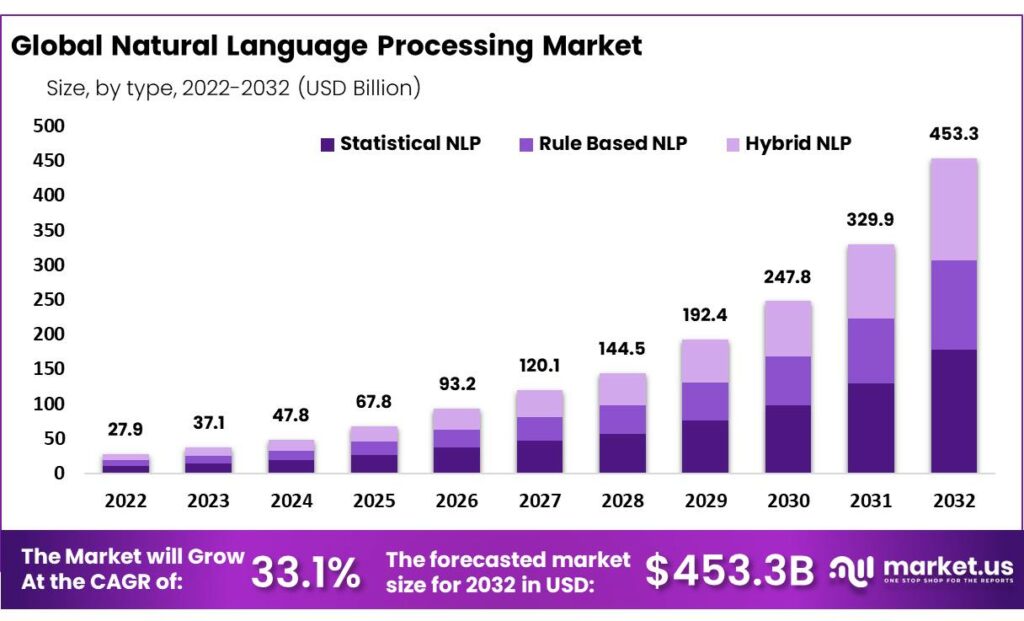
- The Natural Language Processing (NLP) market share is distributed across various industry sectors.
- Among these, the Business & legal services sector holds the largest share at 26.5%, indicating a significant reliance on NLP technologies in this field.
- Media & entertainment follows closely with a substantial market share of 21.2%, reflecting the importance of NLP in content creation and delivery.
- The Energy sector contributes 15.01% to the NLP market.
- In comparison, the Healthcare and Finance sectors have notable but slightly smaller shares at 8.86% and 8.25%, respectively, highlighting their adoption of NLP for applications like healthcare records and financial analysis.
- Security, Transportation, and Retail sectors account for smaller shares of 5.82%, 4.39%, and 4.12%, respectively.
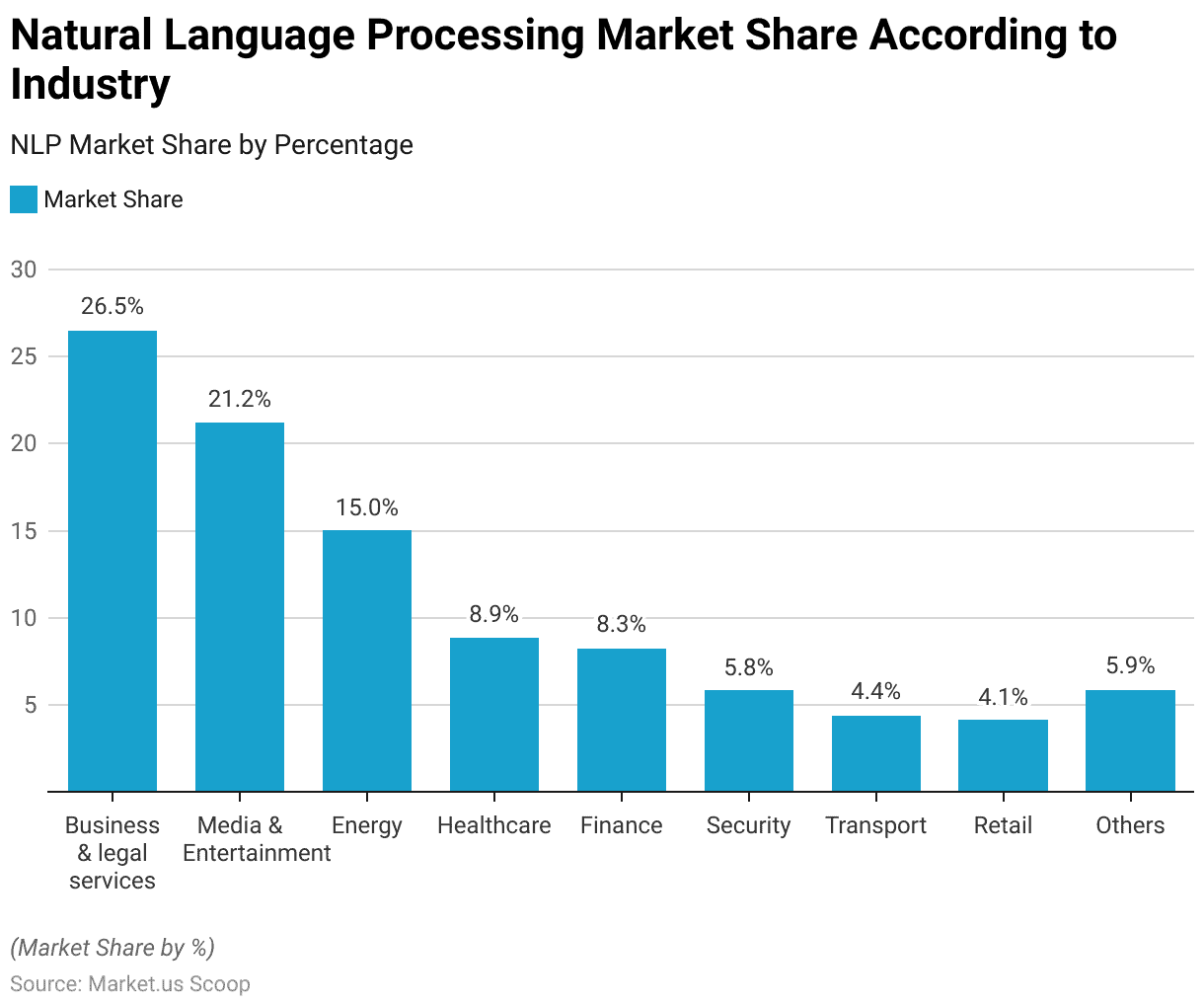
Regional Analysis of Natural Language Processing Market
- The projection is that North America will continue to have the biggest revenue share, making up 30.7% by 2022.
- This is mainly due to the influence of AI and machine learning technologies. Additionally, North America is a significant market for natural language processing services, thanks to the presence of major players like Microsoft and IBM.
- On the other hand, the Asia Pacific region is expected to experience the highest annual growth rate of 43.2% in the foreseeable future.
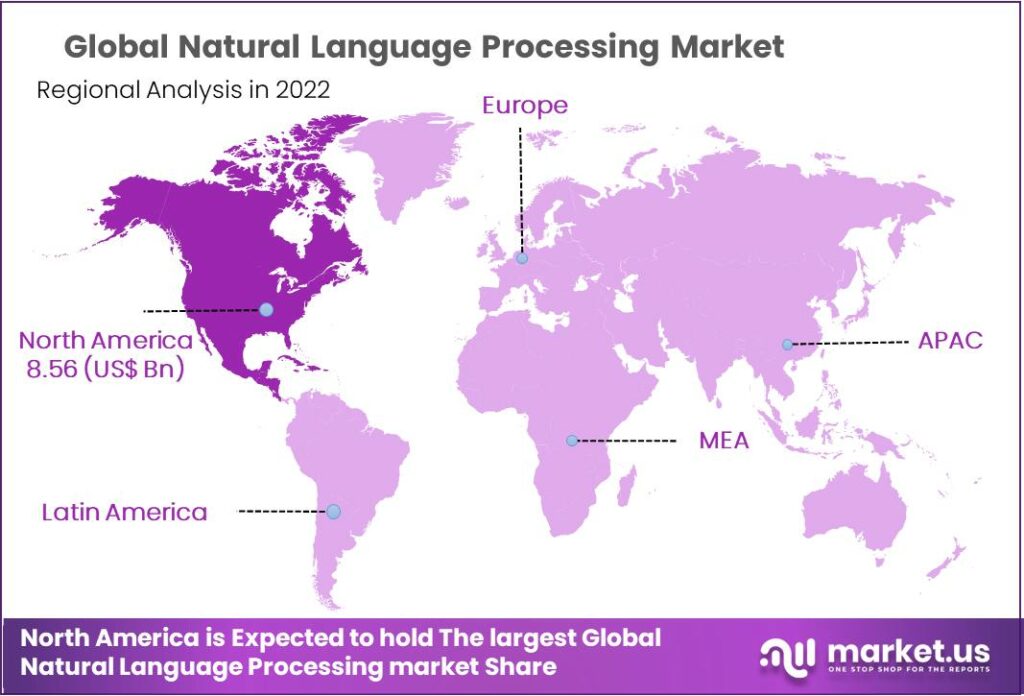
Types of Natural Language Processing
Natural Language Processing Market Revenue- By Type
- The Natural Language Processing (NLP) market is witnessing impressive growth, as the revenue figures from 2022 to 2032 indicate.
- In 2022, the total revenue in this sector stood at USD 27.9 billion. This revenue was primarily generated from three types of NLP technologies: Statistical NLP, Rule-Based NLP, and Hybrid NLP, contributing USD 11.0 billion, USD 7.9 billion, and USD 9.0 billion, respectively.
- Over the following decade, the NLP market experienced substantial expansion. By 2032, the total revenue had skyrocketed to USD 453.3 billion, marking a remarkable growth trajectory.
- Statistical NLP, Rule-Based NLP, and Hybrid NLP technologies continued flourishing, contributing USD 178.2 billion, USD 128.7 billion, and USD 146.4 billion to the overall revenue.
Applications of Natural Language Processing
Natural Language Processing Market Share- By Application
- The Natural Language Processing (NLP) market is diversifying its impact across various applications, contributing to its overall growth and influence.
- Among these applications, Automatic Summarization holds a notable market share of 18.0%, signifying its significance in condensing large volumes of text into concise and informative summaries.
- Content Management follows closely with a 17% market share, underlining its role in efficiently organizing and managing textual content.
- Language Scoring and Sentiment Analysis share a similar market share of 15% and 17%, respectively, showcasing the importance of these applications in evaluating language proficiency and gauging sentiment in text data.
- Data Extraction, with a 10% market share, is vital in extracting structured information from unstructured text, aiding in data analytics and decision-making processes.
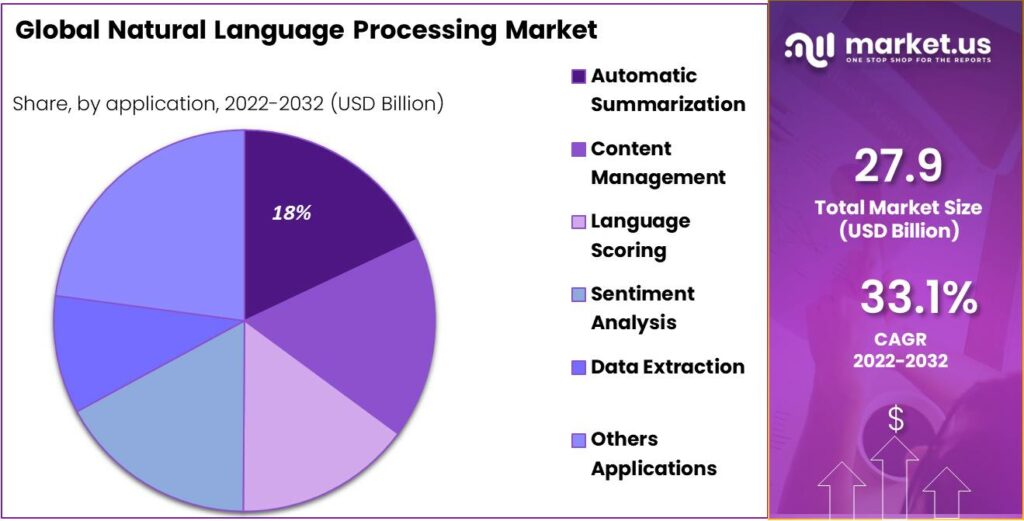
Advantages of Using NLP in Business
- Computational linguistics and natural language processing can efficiently handle large volumes of data from diverse sources and transform them into actionable insights much faster than a human could.
- For instance, Qualtrics XM Discover can transcribe a thousand hours of audio conversations in just one hour, streamlining the process significantly.
- With the help of chatbots powered by NLP, you can automate everyday repetitive tasks, resulting in cost and time savings for your company.
- According to Chatbot Magazine, implementing NLP-driven predefined functions in the automotive sector could reduce customer support costs by as much as 30%.
- Salesforce found that 69% of proficient service agents actively look for chances to utilize artificial intelligence.
Overview of GPT-3: A Useful NLP Model
- GPT-3, an influential artificial intelligence for natural language processing (NLP), was developed by the non-profit organization OpenAI in Silicon Valley, founded by notable figures including Elon Musk and other regional entrepreneurs.
- The GPT-3 neural network was exposed to an extensive corpus of internet-derived natural language comprising over 500 billion words to ensure comprehensive training with vast information.
- This training effort resulted in a model with 175 billion parameters, a significant enhancement compared to its predecessor, GPT-2, which had a mere 1.5 billion parameters, representing a tenfold increase compared to the original GPT model.
Major Companies Advancing Natural Language Processing
Microsoft
- Microsoft Azure has played a pivotal role in training groundbreaking models developed by OpenAI, and these models are currently deployed within Azure to support leading-edge AI products such as GitHub Copilot, DALL·E 2, and ChatGPT.
- In addition, Azure Cognitive Service for Language provides conversational language comprehension capabilities, allowing users to create a component that can be integrated into end-to-end conversational applications.
- By leveraging Google’s machine learning capabilities, Google Cloud’s NLP platform empowers individuals to gain insights from unstructured text.
- AutoML simplifies training custom machine learning models for tasks like classification, sentiment analysis, and entity detection using Vertex AI for natural language, all without requiring extensive machine learning expertise.
- Users can easily upload their training data and test custom models through the AutoML user interface, eliminating the need for coding.
Amazon
- Amazon Web Services (AWS) is a globally recognized and extensively utilized cloud platform, providing over 200 fully equipped services from data centers worldwide.
- One of its services, Amazon Comprehend, employs machine learning to discover valuable insights and associations within textual data.
- Practical applications for this service encompass indexing and searching through product reviews, managing legal briefs, and processing financial documents.
OpenAI
- OpenAI, a company dedicated to AI research and implementation, aims to ensure that artificial general intelligence benefits humanity.
- The launch of OpenAI’s GPT-3 large language model in 2020 marked a significant achievement in natural language processing (NLP).
- Building upon these advancements, its successor, GPT-4, is a substantial multimodal deep-learning model capable of processing text and image inputs and providing textual outputs.
Baidu
- According to SiliconAngle, Baidu has asserted that its Ernie 3.5 chatbot has already surpassed ChatGPT in comprehensive abilities and has outperformed GPT-4 in proficiency in the Chinese language.
- In a mere three months following the beta launch of Ernie Bot, Baidu’s significant language model based on Ernie 3.0 and Ernie 3.5 has seen substantial improvements in effectiveness, functionality, and performance.
Challenges in the Adoption of NLP & Related Technologies
- Among the surveyed businesses, robotics is being used or tested by only 1.2%, with 86% not utilizing them and 13% unsure of their status.
- Automated guided vehicle systems also see limited adoption, with 0.6% in use or testing, 14% unsure, and 86% not using them.
- RFID inventory systems and machine vision software have slightly higher adoption rates, at 1.3%, but still face significant non-adoption and uncertainty.
- Natural language processing is employed or tested by 1.4% of businesses, while voice recognition software has a higher adoption rate at 2.7%.
- Machine learning technology is in use or testing by 2.6% of companies.
- Augmented reality sees adoption among 0.9% of businesses. In contrast, touchscreens and kiosks for customer interfaces are relatively more prevalent, with 6.2% utilizing them.

Future Projections of Natural Language Processing Market
- In 2018, the market saw a robust growth rate of 59.30%, which continued to climb in 2019 at 61.80%.
- However, in 2020, there was a slight dip with a growth rate of 51%, followed by a further decrease to 41.80% in 2021.
- The declining growth trend continued into 2022 when the growth rate stood at 36.50%. The projections suggest a gradual slowing of growth, estimated at 26.50% in 2023, 23% in 2024, and 16% in 2025.
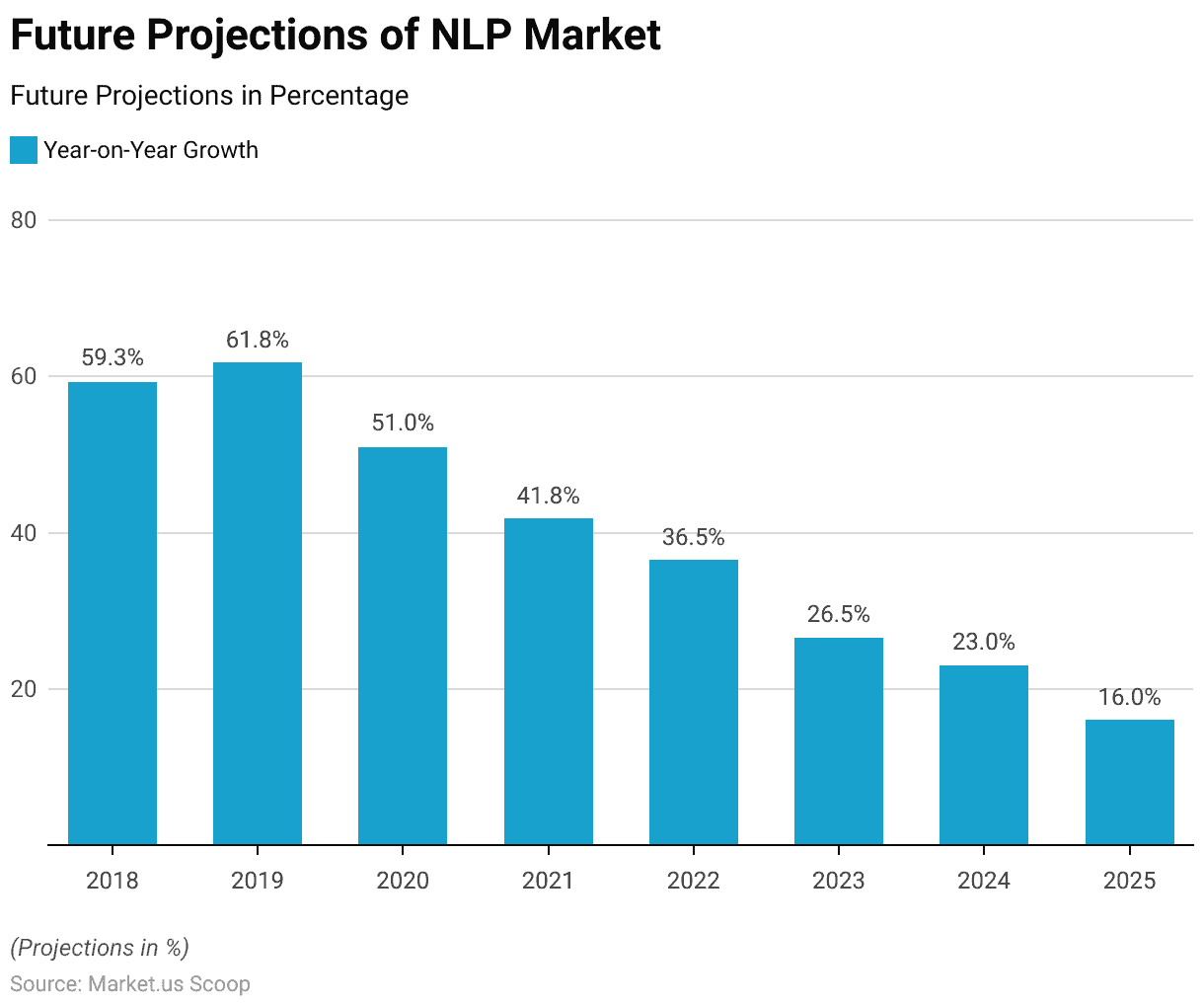
Discuss your needs with our analyst
Please share your requirements with more details so our analyst can check if they can solve your problem(s)



